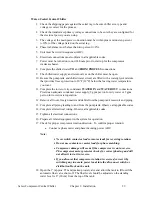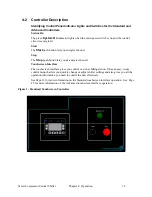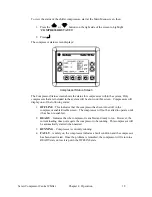
Screw Compressor Central Chiller
Chapter 3: Installation
23
Installing the Remote Air-Cooled Central Chiller Condensers
Remote air-cooled condensers use the surrounding air to cool the refrigerant from the
compressor and release the process heat absorbed from the chilled water into the atmosphere.
All models have variable speed fans and low ambient controls to allow proper operation
down to -20°F (-29°C) outdoor air temperature.
Remote air-cooled central chillers are shipped with a nitrogen holding charge and a full
charge of oil (excluding the amount needed for field piping). The remote air condenser is
shipped with a dry air charge. Verify that the holding charge has not been lost prior to
installation. If there is no pressure, leak test the unit and repair before installing the
interconnecting refrigerant piping.
Read this entire section before installation.
Select a site to install the remote air-cooled condensers where there is:
1.
As short and direct routing of the interconnecting lines as practical.
2.
Free passage of air for condensing.
3.
Adequate structural support.
4.
Protection from strong winds and drifting snow.
5.
Adequate ventilation for removal of heated air from the area.
6.
No steam, hot air, or fume exhausts that can be drawn into the condenser coils.
7.
Adequate space to service unit. See page
XX
for clearance requirements.
Note:
Piping should be type “L” or type “K” refrigerant grade copper tubing only.
Proper sizing and installation has a significant effect on system performance,
reliability and safety.
Interconnecting Refrigerant Piping
The chiller and condenser refrigerant lines are terminated with a cap and brazed closed. Use
a tube cutter to remove caps.
Caution!
Do not use a saw to remove the end caps because this will allow copper
chips to contaminate the system.
A certified refrigeration contractor is needed to install the interconnecting refrigerant piping
between the chiller and the outdoor air-cooled condenser and charge the unit with refrigerant.
This piping must be properly sized, type “L” or type “K” refrigerant grade tubing, high
temperature brazed.
Note:
He must install a 400 PSI approved refrigerant relief valve in the discharge
line at the condenser, following all codes.
When brazing copper joints, flow dry nitrogen through the system to prevent carbon/scale
formation, which causes contamination. Isolate the refrigerant lines from the building,
preventing transfer of line vibration to the structure. Do not secure the lines rigidly.
Leak check and evacuate the system down to 400 microns. A maximum decay of 50 microns
after one hout is acceptable.
WARNING!
To prevent injury or death due to explosion and/or inhalation of phosgene gas, purge
system thoroughly while brazing refrigerant piping connections. Use a pressure
regulator in the line between the unit and the high-pressure nitrogen cylinder to avoid
over-pressurization and possible explosion.
















































